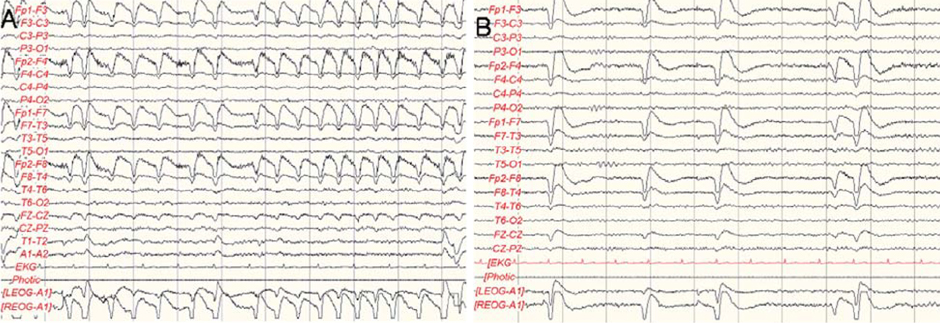J Clin Neurol.
2007 Jun;3(2):93-95. 10.3988/jcn.2007.3.2.93.
A Case of Lamotrigine-Induced Excessive Involuntary Eye Blinking
- Affiliations
-
- 1Department of Neurology, Pochon CHA University, College of Medicine, Sungnam, Korea. okjun77@cha.ac.kr
- KMID: 1851019
- DOI: http://doi.org/10.3988/jcn.2007.3.2.93
Abstract
- A wide variety of movement disorders can be induced by the administration of antiepileptic drugs. A 44-year-old female was admitted with involuntary excessive eye blinking that manifested 5 months after beginning the administration of lamotrigine for control of complex partial and secondarily generalized seizures. The involuntary eye blinking persisted while taking lamotrigine, and disappeared 1 month after the cessation of lamotrigine. The development of atypical involuntary eye blinking in this case may have resulted from the inhibition of excitatory neurotransmitters by lamotrigine, which led to secondary dysfunction of the dopaminergic system.
Keyword
MeSH Terms
Figure
Reference
-
1. Leach MJ, Marsden CM, Miller AA. Pharmacological studies on lamotrigine, a novel potential antiepileptic drug: II. Neurochemical studies on the mechanism of action. Epilepsia. 1986. 27:490–497.
Article2. Das KB, Harris C, Smyth DP, Cross JH. Unusual side effects of lamotrigine therapy. J Child Neurol. 2003. 18:479–480.
Article3. Sotero de Menezes MA, Rho JM, Murphy P, Cheyette S. Lamotrigine-induced tic disorder: report of five pediatric cases. Epilepsia. 2000. 41:862–867.
Article4. Esteban A, Traba A, Prieto J. Eyelid movements in health and disease. The supranuclear impairment of the palpebral motility. Neurophysiol Clin. 2004. 34:3–15.
Article5. Ebert D, Albert R, Hammon G, Strasser B, May A, Merz A. Eye-blink rates and depression. Is the antidepressant effect of sleep deprivation mediated by the dopamine system? Neuropsychopharmacology. 1996. 15:332–339.
Article6. Karas BJ, Wilder BJ, Hammond EJ, Bauman AW. Valproate tremors. Neurology. 1982. 32:428–432.
Article7. Turkdogan D, Onat F, Ture U, Pamir N. Phenytoin toxicity with mandibular tremor secondary to intravenous administration. Int J Clin Pharmacol Ther. 2002. 40:18–19.
Article8. Saito Y, Oguni H, Awaya Y, Hayashi K, Osawa M. Phenytoin-induced choreoathetosis in patients with severe myoclonic epilepsy in infancy. Neuropediatrics. 2001. 32:231–235.
Article9. Gunal DI, Guleryus M, Bingol CA. Reversible valproateinduced choreiform movements. Seizure. 2002. 11:205–206.
Article10. Verma A, Miller P, Carwile ST, Husain AM, Radtke RA. Lamotrigine-induced blepharospasm. Pharmacotherapy. 1999. 19:877–880.
Article11. Zipp F, Baas H, Fischer PA. Lamotrigine-antiparkinsonian activity by blockade of glutamate release? J Neural Transm Park Dis Dement Sec. 1993. 5:67–75.
Article


